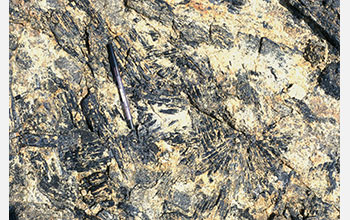

Spectacular, randomly-oriented prisms of the borosilicate mineral prismatine on a foliation plane can be seen in this outcrop east of Prismatine Peak. Originally reported to be tourmaline--a relatively common borosilicate--by researchers in the late 1980s, later research found that the large prisms were actually prismatine, another silicate mineral containing boron as an essential constituent but far more limited in occurrence. Correcting the mineral identification resulted in the renaming of "Tourmaline Peak" to "Prismatine Peak," the official name for the prominent hill on central Stornes Peninsula where prismatine spectacularly occurs.
In November 2003, Edward S. Grew, a research professor in the School of Earth and Climate Sciences at the University of Maine in Orono, and Christopher J. Carson, a senior Antarctic geoscientist with Geoscience Australia in Canberra, were part of a team of researchers that travelled to Antarctica's Larsemann Hills as part of a study to determine how abundant boron and phosphorus were in the area, and to suggest an explanation for why there might be an exceptional enrichment there. The trip began a decade-long research project that culminated in the 2014 designation of the area as an Antarctic Specially Protected Area (ASPA).
The Larsemann Hills are a 40-square-kilometer region of rocky islands and promontories on the eastern shore of Prydz Bay. Previous studies of the area suggested that boron and phosphorus were there in large quantities, which would be particularly exciting because the two elements are rarely found in more than trace amounts in highly deformed and metamorphosed rocks such as the granulite-facies metamorphic rocks exposed in the Larsemann Hills.
Credit: Edward S. Grew, University of Maine |

Nenhum comentário:
Postar um comentário
Observação: somente um membro deste blog pode postar um comentário.